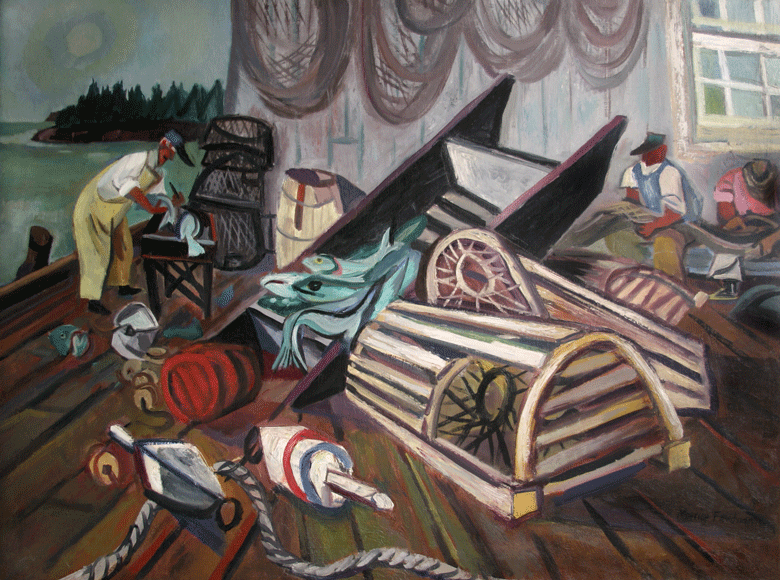The town of Stonington’s fish pier has a Facebook page. In addition to informational posts, the page features photos of the pier and its surroundings taken by visitors. There are views down Main Street, a shot of William Muir’s monument to local stonecutters, and a study of colorful lobster buoys. The latter image underscores Stonington’s status as one of the most active lobstering ports in the country, if not the world.
Maurice Freedman’s painting Stonington Pier brings to life this center of fishing activity in an earlier era, the 1950s. The 30-by-40-inch oil on canvas offers the full range of marine enterprise, from a fisherman cutting fish on the left, through lobster traps in the middle, to net menders on the right.
Given the period, observes Penobscot Marine Museum curator Ben Fuller, the fish are likely cod, “which would be split for drying or at least cleaned for sale.” Inshore dragging would have been the harvesting method. “Indeed,” writes Fuller, “the gents to the right would be repairing or working on the net.”
Freedman (1904-1985) is considered an American modernist…
The double-ended object in the center of the painting, Stonington ocean ecologist Ted Ames believes, might be a fish keeler used for cleaning fish. As he explains:
“One end of the keeler would be set perpendicular to the side of a fish pen with the other end over the combing on the side of the boat. Fish would be tossed into the keeler and dressed (cut and gutted), then tossed into a pen or the hold, if it had one. Mine had a solid plywood bottom with the end on one side fastened a couple inches off the bottom, so the innards would slide out over the side of the boat.
“The one in the painting has slats nailed across the bottom, so the offal would slide out onto to deck and have to be hosed out through a scupper.”
Freedman (1904-1985) is considered an American modernist, often listed with such contemporaries as Marsden Hartley, Arthur Dove, and Milton Avery. He is closest to Hartley: The simplified trees off to the left, the faceless fishermen, and the length of rope in the foreground might have been painted by the Lewiston-born artist.
Like Hartley and company, Freedman was exposed to modern art early on, studying in Paris with André Lhote and Fernand Léger. According to New York Times critic John Russell, he learned from his teachers “how to draw with a loaded brush, how to handle rich and strong color without letting it get out of hand, and how to give individuality to the objects of the everyday.”
All three lessons play out in Stonington Pier where the paint is applied with verve, the color scheme is bold but within reason, and each element is delineated with care yet with freedom of delivery.
In an interview with his son Joel, Freedman described how being sensitive to “what’s there” was “like a door that suddenly opens and then you slowly walk in.” Once inside, the painter would subsequently review the colors and forms around him and set out to discover the logic of the scene. “All this is so reassuring to your life,” Freedman noted, “that you go on living because it’s so beautiful.”
The same goes for the viewer of Freedman’s Stonington Pier. We enter this world he saw and painted and find a kind of comfort in the tableau: men hard at work, a bounty of fish, where every object is meaningful.
Carl Little’s latest book is Mary Alice Treworgy: A Maine Painter.





